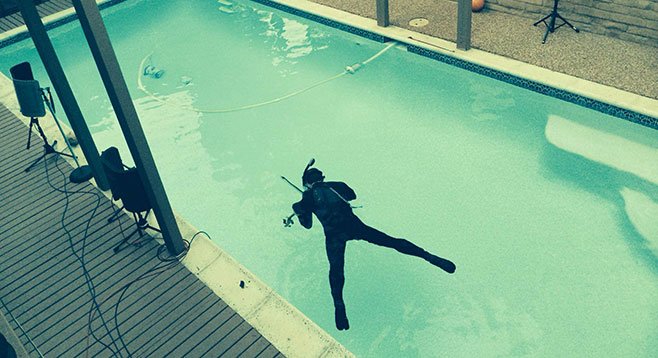 Facebook
Facebook
 X
X
 Instagram
Instagram
 TikTok
TikTok
 Youtube
Youtube

“We have this crazy house with a swimming pool. We’d lived here for eight months before I said, ‘Wait a minute...this isn’t a pool. It’s an underwater recording studio.’” Ever since Joseph Waters joined the faculty at San Diego State University a decade or so ago, he’s expressed a yearning to perform music underwater. Seeming impossible, but not so odd, considering that Waters turned the 25th Street overpass in Golden Hill into a giant xylophone and once filled his recording studio with live wasps.
The submarine concept was put on the back burner until recently, with the convergence of two seemingly disparate events. One was the purchase of a poolside home on Mt. Helix, near La Mesa. The other was the invention of a fiddle meant to be played underwater. Waters got one, plunged a hydrophone into the blue depths, and began recording in earnest. “Sound travels really well under water. And the pool is like a room with a wall that changes in incredibly different ways. I’m still trying to understand what happens to sound when the surface has disruptions in it, like waves or irregular ripples.”
Waters, 61, is a professor of composition and computer music at San Diego State University. The study of sound underwater is not all that new. “The Navy knows about it because they want to communicate and they want to blow things up. And people have been trying to figure out whale songs forever. But using water for music is relatively new.” A sheepish grin spreads across his features. “Most people don’t use their pools for this sort of thing.”
Waters previews a preliminary mix of his first composition with the submersible violin. “Raccoons in the Pool” is a fanciful piece that shapeshifts, builds on maddening waves of tension, then resolves in a crest of sonic textures. “It’s user-friendly, but it has depth.” He claims raccoons as his inspiration; Mt. Helix, it turns out, is lousy with them.
Waters’s son Zuriel created a video to accompany the electronic concerto, slated to premiere at this year’s New West Electronic Arts and Music Organization. Waters, who is both founder and artistic director of NWEAMO, arranged for the event to be held at the Reuben H. Fleet Science Center.
“Three or four years ago, I was thinking, I sure would like to play with the IMAX [now called the Heikoff Dome] theater.” He made contact with IMAX projectionist John Young. “I told him about my ideas and he said okay, but not until the theater was retrofitted for video.” Years passed. “Then, I got an email from Young stating that the retrofit had finally taken place. And he said I could come and play with the new system.”


“We have this crazy house with a swimming pool. We’d lived here for eight months before I said, ‘Wait a minute...this isn’t a pool. It’s an underwater recording studio.’” Ever since Joseph Waters joined the faculty at San Diego State University a decade or so ago, he’s expressed a yearning to perform music underwater. Seeming impossible, but not so odd, considering that Waters turned the 25th Street overpass in Golden Hill into a giant xylophone and once filled his recording studio with live wasps.
The submarine concept was put on the back burner until recently, with the convergence of two seemingly disparate events. One was the purchase of a poolside home on Mt. Helix, near La Mesa. The other was the invention of a fiddle meant to be played underwater. Waters got one, plunged a hydrophone into the blue depths, and began recording in earnest. “Sound travels really well under water. And the pool is like a room with a wall that changes in incredibly different ways. I’m still trying to understand what happens to sound when the surface has disruptions in it, like waves or irregular ripples.”
Waters, 61, is a professor of composition and computer music at San Diego State University. The study of sound underwater is not all that new. “The Navy knows about it because they want to communicate and they want to blow things up. And people have been trying to figure out whale songs forever. But using water for music is relatively new.” A sheepish grin spreads across his features. “Most people don’t use their pools for this sort of thing.”
Waters previews a preliminary mix of his first composition with the submersible violin. “Raccoons in the Pool” is a fanciful piece that shapeshifts, builds on maddening waves of tension, then resolves in a crest of sonic textures. “It’s user-friendly, but it has depth.” He claims raccoons as his inspiration; Mt. Helix, it turns out, is lousy with them.
Waters’s son Zuriel created a video to accompany the electronic concerto, slated to premiere at this year’s New West Electronic Arts and Music Organization. Waters, who is both founder and artistic director of NWEAMO, arranged for the event to be held at the Reuben H. Fleet Science Center.
“Three or four years ago, I was thinking, I sure would like to play with the IMAX [now called the Heikoff Dome] theater.” He made contact with IMAX projectionist John Young. “I told him about my ideas and he said okay, but not until the theater was retrofitted for video.” Years passed. “Then, I got an email from Young stating that the retrofit had finally taken place. And he said I could come and play with the new system.”
Comments